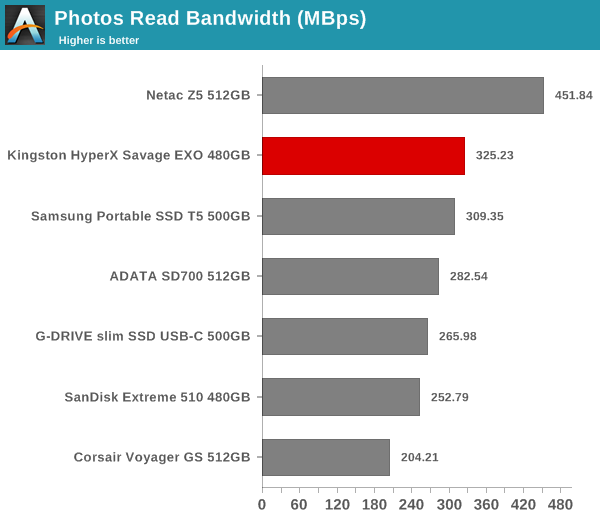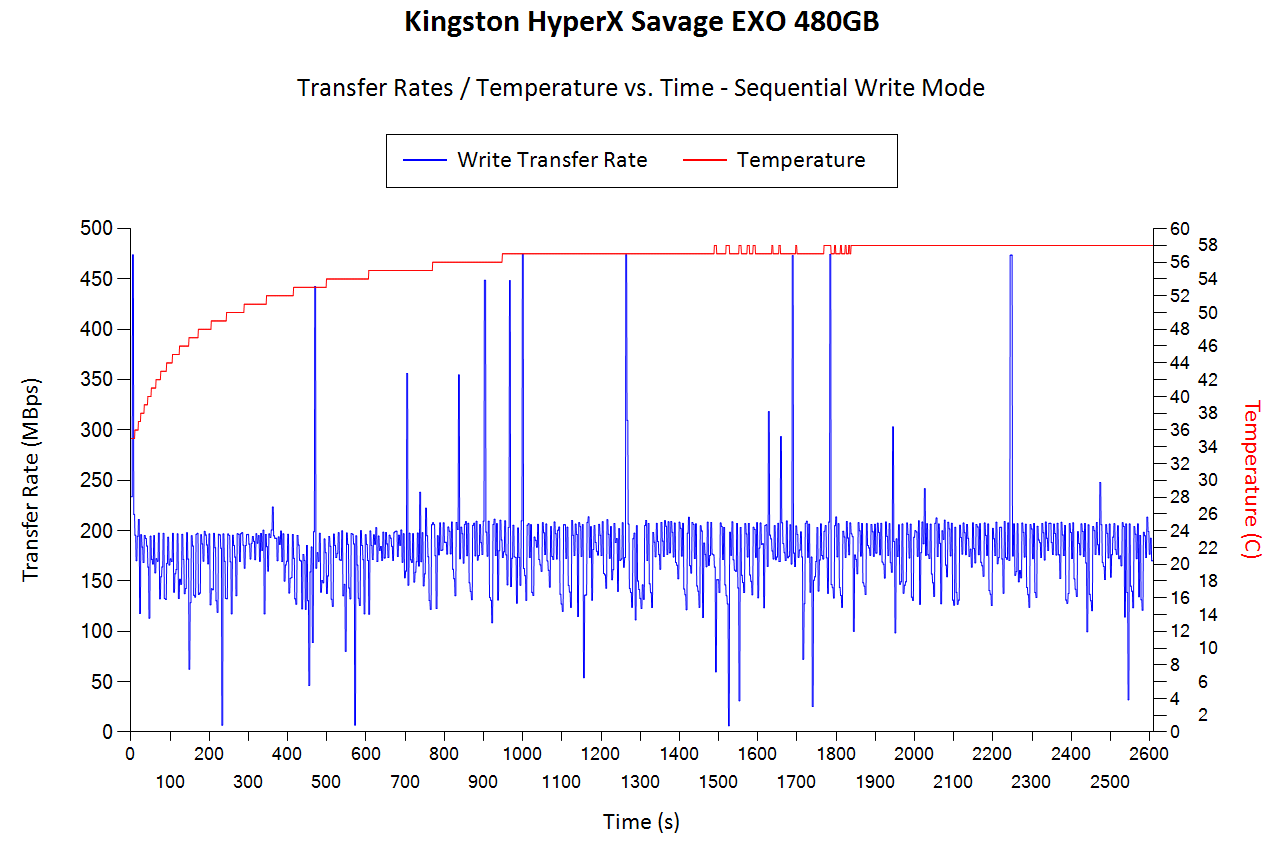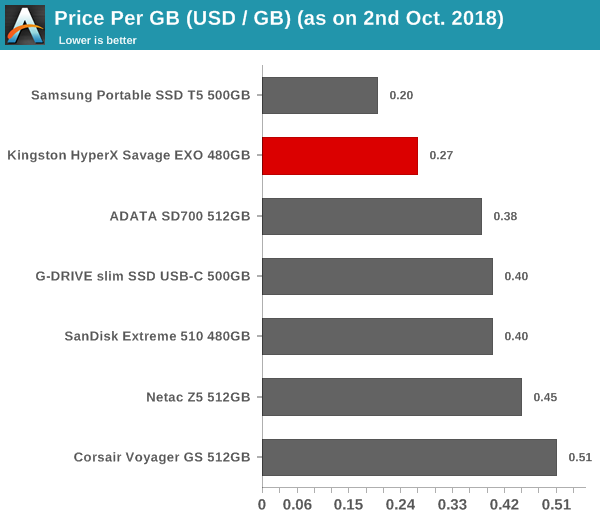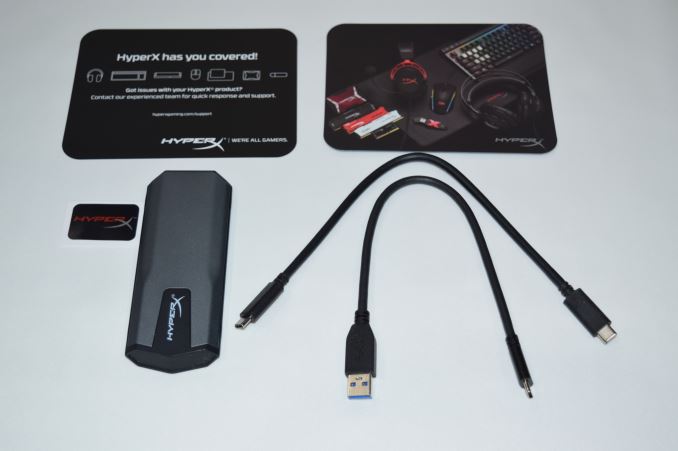Kingston HyperX Savage EXO External SSD Capsule Review
by Ganesh T S on October 2, 2018 4:00 PM EST
The advent of 3D TLC flash has enabled a large number of budget-friendly bus-powered solid-state storage devices. On the external front, these devices fall under three major categories:
- Thumb drives: These usually come with USB 2.0 or USB 3.0 interfaces, and are meant to plug in directly into the host port without an extra cable. Capacities have been steadily increasing, though very few high-end models boast of peak performance in the 300 - 400 MBps range. Most low-end and mid-range thumb drives have write speeds of the order of 20 - 80 MBps, and read speeds of the order of 100 - 150 MBps.
- External SSDs (USB interface): Over the last few years, we have had vendors place a 2.5" SSD board behind a SATA - USB 3.0 bridge. These have now evolved into M.2 SATA SSDs behind a much smaller and more power-efficient SATA - USB 3.1 Gen 2 Type-C bridge. Such external SSDs now make up the bulk of the mid-range and high-end bus-powered external direct-attached storage devices.
- External SSDs (Thunderbolt 3 interface): Consumers requiring very bus-powered external storage with very high performance are served by Thunderbolt 3 SSDs that are surprisingly affordable despite their performance profile. These SSDs put a M.2 PCIe NVMe SSD behind a Thunderbolt 3 controller and deliver performance equivalent to an internal PCIe 3.0 x4 M.2 NVMe drive.
Kingston's HyperX Savage EXO SSD falls into the second category. It puts a M.2 2280 SATA SSD behind a SATA-to-USB 3.1 Gen 2 Type-C board and encloses them in a stylish case to target gamers. Kingston claims speeds of up to 500 MBps reads / 480 MBps writes, and a 20% reduction in game load times when used with leading game consoles. Does the product deliver on its claims, and more importantly, how does it fare against alternatives in the market?
Introduction
Kingston is no stranger to the external flash storage market, and its HyperX brand has produced some of the best-performing thumb drives using a flash controller with a direct USB interface. Kingston has also been a trusted vendor in the internal SSD space. It is surprising that we haven't had an external SSD from Kingston prior to the launch of the HyperX Savage EXO.
The HyperX Savage EXO is a 124mm x 49mm x 10mm device weighing 56g. The form-factor points to the use of a M.2 2280 SSD inside. It has a Type-C interface, and Kingston bundles two 12 in. USB cables (1x Type-C to Type-C, and, 1x Type-A to Type-C) along with the device. The drive comes pre-formatted in exFAT, allowing it to be used out-of-the-box with Windows PCs, Macs, and various game consoles.
Prior to looking at the internals, CrystalDiskInfo provides some insights.
| Drive Information |
 |
Most of the S.M.A.R.T attributes are vendor-specific, but, the key takeaway here is the ability to activate TRIM on the SSD, and the ability to get an idea of the wear on the drive.
Teardown and Internals
The HyperX Savage EXO external SSD is a well-built device with no screws holding the case together. Opening up the device involved prying out the casing at the seams - quite a difficult exercise compared to our experience with other external storage devices. The M.2 2280 SATA SSD seems to be the M.2 version of the Fury RGB SSD that was released along with the Savage EXO. The Toshiba BiCS 64L 3D TLC flash is packaged by Kingston and a Marvell 88SS1074 controller is present on the single-sided PCB. If this combination sounds familiar, it is actually the same hardware as our favorite external SSD - the SanDisk Extreme Portable SSD. The firmware is obviously quite different, as Marvell gives plenty of leeway to the SSD manufacturers to differentiate themselves compared to vendors such as Phison and Silicon Motion who have more turnkey designs.
The M.2 SSD is connected to a small board that actually sports the Type-C interface. ASMedia's ASM235CM, acting as a SATA - USB 3.1 Gen 2 bridge chip, is the major component in this board. Again, this is the bridge chip used in popular high-performance external SSDs such as the SanDisk Extreme Portable SSD and the Samsung T5 Portable SSD. The only thermal protection is a single thermal pad affixed to the case that completely covers the M.2 SSD. As we shall see further down, the thermals are not a concern for the HyperX Savage EXO's performance.
In the rest of the review, we have the list of DAS units compared against each other on various metrics:
- Kingston HyperX Savage EXO 480GB
- ADATA SD700 512GB
- ADATA SV620 480GB
- Corsair Voyager GS 512GB
- G-DRIVE slim SSD USB-C 500GB
- Netac Z5 512GB
- Samsung Portable SSD T5 500GB
- SanDisk Extreme 510 480GB
Prior to looking at the benchmark numbers, we take a brief detour to look at our evaluation setup.
Testbed Setup and Testing Methodology
Evaluation of DAS units on Windows is done with the testbed outlined in the table below. For devices with a USB 3.1 Gen 2 (via a Type-C interface) connection (such as the Kingston HyperX Savage EXO 480GB that we are considering today), we utilize the USB 3.1 Type-C port enabled by the Intel Alpine Ridge controller. It connects to the Z170 PCH via a PCIe 3.0 x4 link.
| AnandTech DAS Testbed Configuration | |
| Motherboard | GIGABYTE Z170X-UD5 TH ATX |
| CPU | Intel Core i5-6600K |
| Memory | G.Skill Ripjaws 4 F4-2133C15-8GRR 32 GB ( 4x 8GB) DDR4-2133 @ 15-15-15-35 |
| OS Drive | Samsung SM951 MZVPV256 NVMe 256 GB |
| SATA Devices | Corsair Neutron XT SSD 480 GB Intel SSD 730 Series 480 GB |
| Add-on Card | None |
| Chassis | Cooler Master HAF XB EVO |
| PSU | Cooler Master V750 750 W |
| OS | Windows 10 Pro x64 |
| Thanks to Cooler Master, GIGABYTE, G.Skill and Intel for the build components | |
The full details of the reasoning behind choosing the above build components can be found here.
Synthetic Benchmarks - ATTO and Crystal DiskMark
Kingston claims read and write speeds of 500 and 480 MBps respectively, and these are backed up by the ATTO benchmarks provided below. Unfortunately, these access traces are not very common in real-life scenarios.
| Drive Performance Benchmarks - ATTO |
 |
CrystalDiskMark, despite being a canned benchmark, provides a better estimate of the performance range with a selected set of numbers. As evident from the screenshot below, the performance can dip to as low as 20 MBps for random reads.
| Drive Performance Benchmarks - CrystalDiskMark |
 |
Benchmarks - robocopy and PCMark 8 Storage Bench
Our testing methodology for DAS units also takes into consideration the usual use-case for such devices. The most common usage scenario is transfer of large amounts of photos and videos to and from the unit. The minor usage scenario is importing files directly off the DAS into a multimedia editing program such as Adobe Photoshop.
In order to tackle the first use-case, we created three test folders with the following characteristics:
- Photos: 15.6 GB collection of 4320 photos (RAW as well as JPEGs) in 61 sub-folders
- Videos: 16.1 GB collection of 244 videos (MP4 as well as MOVs) in 6 sub-folders
- BR: 10.7 GB Blu-ray folder structure of the IDT Benchmark Blu-ray (the same that we use in our robocopy tests for NAS systems)

For the second use-case, we take advantage of PC Mark 8's storage bench. The storage workload involves games as well as multimedia editing applications. The command line version allows us to cherry-pick storage traces to run on a target drive. We chose the following traces.
- Adobe Photoshop (Light)
- Adobe Photoshop (Heavy)
- Adobe After Effects
- Adobe Illustrator
Usually, PC Mark 8 reports time to complete the trace, but the detailed log report has the read and write bandwidth figures which we present in our performance graphs. Note that the bandwidth number reported in the results don't involve idle time compression. Results might appear low, but that is part of the workload characteristic. Note that the same testbed is being used for all DAS units. Therefore, comparing the numbers for each trace should be possible across different DAS units.

Performance Consistency
Yet another interesting aspect of these types of units is performance consistency. Aspects that may influence this include thermal throttling and firmware caps on access rates to avoid overheating or other similar scenarios. This aspect is an important one, as the last thing that users want to see when copying over, say, 100 GB of data to the flash drive, is the transfer rate going to USB 2.0 speeds. In order to identify whether the drive under test suffers from this problem, we instrumented our robocopy DAS benchmark suite to record the flash drive's read and write transfer rates while the robocopy process took place in the background. For supported drives, we also recorded the internal temperature of the drive during the process. The graphs below show the speeds observed during our real-world DAS suite processing. The first three sets of writes and reads correspond to the photos suite. A small gap (for the transfer of the videos suite from the primary drive to the RAM drive) is followed by three sets for the next data set. Another small RAM-drive transfer gap is followed by three sets for the Blu-ray folder.
An important point to note here is that each of the first three blue and green areas correspond to 15.6 GB of writes and reads respectively. Throttling, if any, is apparent within the processing of the photos suite itself. The HyperX Savage EXO doesn't exhibit any signs of thermal throttling, but, it does seem to have a really small SLC cache as shown by the drop in write speeds from ~300 MBps to ~175 MBps very early on in the Photos suite.
| Performance Consistency and Thermal Characteristics |
 |
The HyperX Savage EXO has an excellent thermal solution with temperatures not exceeding 58 C even after being subject to more than 200GB of non-stop traffic. This is a combination of the thermal solution (silicone pad and case design) as well as the lowered write speeds after the SLC cache gets filled.
Miscellaneous Aspects and Concluding Remarks
The performance consistency for real-world applications was looked at in the previous sub-section. We recently added a test to determine the effectiveness of the thermal solution for sustained workloads. After deleting the SSD volume, a fio workload was set up to write sequential data to the raw drive with a block size of 128K and iodepth of 32 to cover 90% of the drive capacity. The internal temperature, instantaneous write data rate, and total amount of data written in total till that point of time were recorded.
| Sequential Write to 90% of Disk Capacity - Performance Consistency |
 |
We see the write speed start off around the claimed numbers (~480 MBps), but, within a few seconds, the speeds drop down to the sub-200 MBps range. As the writes keep on piling up, speeds sometimes drop down to the low 10 MBps range, though a similar number of 450 MBps+ peaks also exist. On the whole, consistency is not a hallmark of the drive under sustained write workloads.
The above exercise also allows us to determine the SLC cache size and/or the amount of data that can be written in one shot without a drop in the write data rate. The graph below plots the transfer rate and the total data transfer amount from the start of the fio workload to the approximate timestamp at which the transfer rate shows a significant drop.
| Sustained Writes - Characteristics |
 |
We see the write speed drop down from ~480 MBps to ~200 MBps after writing around 2.5 - 3 GB of data continuously.
The HyperX Savage EXO is a bus-powered device, and it is given that the peak power consumption can't go beyond 4.5W to maintain compatibility with as wide a range of systems as possible. It is still relevant to take a fine-grained look at the power consumption profile. Using the Plugable USBC-TKEY, the bus power consumption for the device was tracked while the CrystalDiskMark workloads were processed. The workloads were set up with an interval time of 30s.
| Drive Power Consumption - CrystalDiskMark Workloads |
 |
We see that the SSD idles around the 1.8W mark, and the peak power consumption (under heavy sequential write workloads) is just short of 4W.
The Kingston HyperX Savage EXO SSD supports TRIM under Windows as long as the volume is formatted in NTFS.
Moving on to the pricing aspect, the drive was launched at $220 on September 23rd, 2018. It is available on Amazon right now for $128. Of all the SSDs that we have evaluated in its capacity class, only the Portable SSD T5 from Samsung at $100 has a lower price per GB. Samsung's pricing is hard to beat due to the vertically integrated nature of its SSD business. We have not directly evaluated the SanDisk Extreme Portable SSD's 500GB version, but, its 1TB version impressed us a lot. The SanDisk Extreme Portable SSD 500 GB is priced at $110.

Even at $128, we believe that the Kingston HyperX Savage EXO a hard sell. To its credit, the device is currently Kingston's fastest bus-powered external storage device. The performance, as we see in the graphs above, is better than the external SSDs from various vendors released in the 2015 - 2017 timeframe. The hardware inside the Savage EXO is certainly powerful (it is essentially the same Marvell 88SS1074 controller, Toshiba / SanDisk BiCS 64L 3D TLC flash, and the ASMedia ASM235CM SATA-USB bridge as the SanDisk Extreme Portable SSD). However, the firmware needs a major overhaul in order to better serve the needs of its target market.

















1 Comments
View All Comments
jabber - Tuesday, October 2, 2018 - link
My that's an old version of DiskMark!